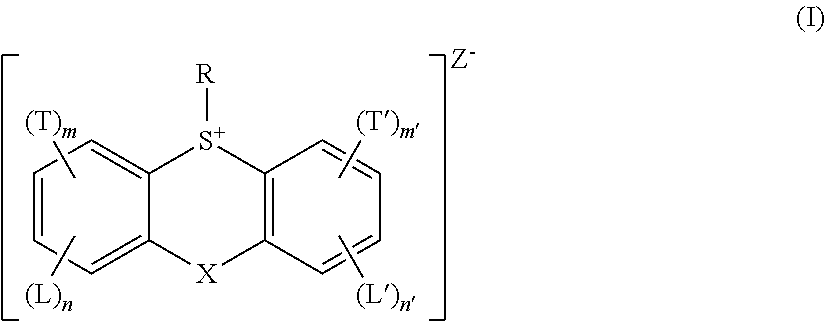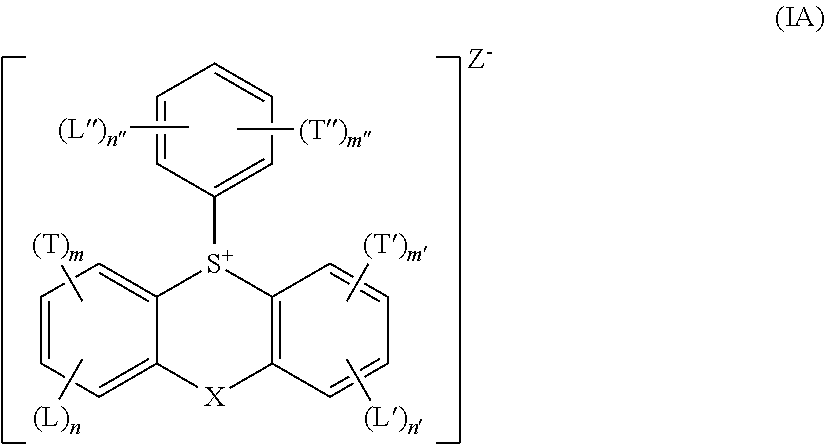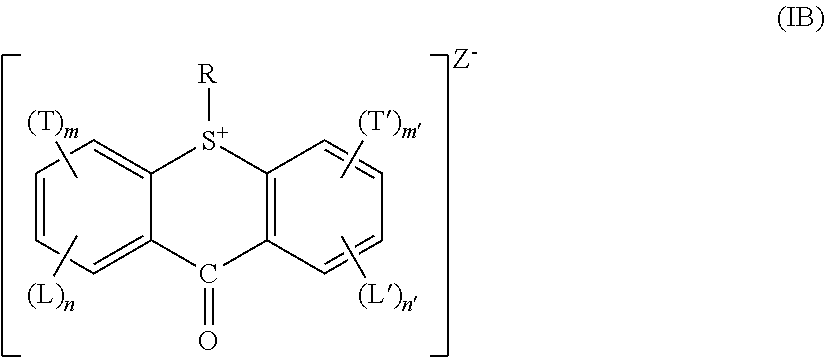Photoresists comprising multiple acid generator compounds
a photoresist and acid generator technology, applied in the field of new photoresist compositions, can solve the problems that euv photoresist development remains a challenging issue in the implementation of euv lithography (euvl) technology, and achieve enhanced lithographic results, good line edge roughness and contrast, and high relative weight
- Summary
- Abstract
- Description
- Claims
- Application Information
AI Technical Summary
Benefits of technology
Problems solved by technology
Method used
Image
Examples
examples 1-18
Syntheses of acid generator compounds
example 1
Synthesis of 5-phenyl-5H-dibenzo[b,d]thiophenium 3-hydroxyadamantane-acetoxy-1,1,2,2-tetrafluorobutane-1-sulfonate
[0083]
[0084]5-phenyl-5H-dibenzo[b,d]thiophenium bromide (28.0 g, 82.04 mmol) and 3-hydroxyadamantane-acetoxy-1,1,2,2-tetrafluorobutane-1-sulfonate-sodium salt (35.68 g, 83.7 mmol) were dissolved in dichloromethane (500 mL) and water (500 mL) and stirred at r.t. for 16 h. The dichloromethane layer was separated and the aqueous phase washed with dichloromethane (3×300 mL). The combined organic layers were washed with water (4×500 mL), concentrated in vacuo and residual water removed via azeotrope with acetonitrile (2×350 mL) to afford the title compound (54.00 g, 99%) as a white solid. 1H NMR (500 MHz, (CD3)2CO) δ: 8.55 (d, J=8 Hz, 2H), 8.41 (d, J=8 Hz, 2H), 8.02 (dt, J=7.5, 0.5 Hz, 2H), 7.77-7.84 (m, 5H), 7.67 (t, J=7.5 Hz, 2H), 4.31 (t, J=6.5 Hz, 2H), 3.63 (s, 10H), 2.71 (tt, J=14, 6.5 Hz, 2H), 1.52-1.80 (m, 12H).
example 2
Synthesis of 5-phenyl-5H-dibenzo[b,d]thiophenium 1,1-difluoro-2-(methacryloyloxy)ethanesulfonate
[0085]
[0086]5-phenyl-5H-dibenzo[b,d]thiophenium bromide (80.0 g, 234 mmol) and triethylammonium 1,1-difluoro-2-(methacryloyloxy)ethanesulfonate (78.5 g, 238 mmol) were dissolved in H2O (750 mL) and dichloromethane (750 mL) and stirred at r.t. for 18 h. The dichloromethane layer was separated and the aqueous phase washed with dichloromethane (3×500 mL). The combined organic layers were washed with water (3×1 L) and concentrated in vacuo to afford the title compound (109 g, 95%) as a white solid. 1H NMR (500 MHz, (CD3)2CO) δ: 8.56 (dd, J=7.5, 1 Hz, 2H), 8.42 (d, J=8 Hz, 2H), 8.05 (dt, J=8 Hz, 1 Hz, 2H), 7.77-7.87 (m, 5H), 7.69 (dt, J=8, 1 Hz, 2H), 6.14-6.16 (m, 1H), 5.66-5.69 (m, 1H), 4.75 (dd, J=15, 15 Hz, 2H), 1.93-1.94 (m, 3H).
PUM
| Property | Measurement | Unit |
|---|---|---|
| wavelength | aaaaa | aaaaa |
| wavelength | aaaaa | aaaaa |
| photoresist composition | aaaaa | aaaaa |
Abstract
Description
Claims
Application Information
 Login to View More
Login to View More - R&D
- Intellectual Property
- Life Sciences
- Materials
- Tech Scout
- Unparalleled Data Quality
- Higher Quality Content
- 60% Fewer Hallucinations
Browse by: Latest US Patents, China's latest patents, Technical Efficacy Thesaurus, Application Domain, Technology Topic, Popular Technical Reports.
© 2025 PatSnap. All rights reserved.Legal|Privacy policy|Modern Slavery Act Transparency Statement|Sitemap|About US| Contact US: help@patsnap.com



